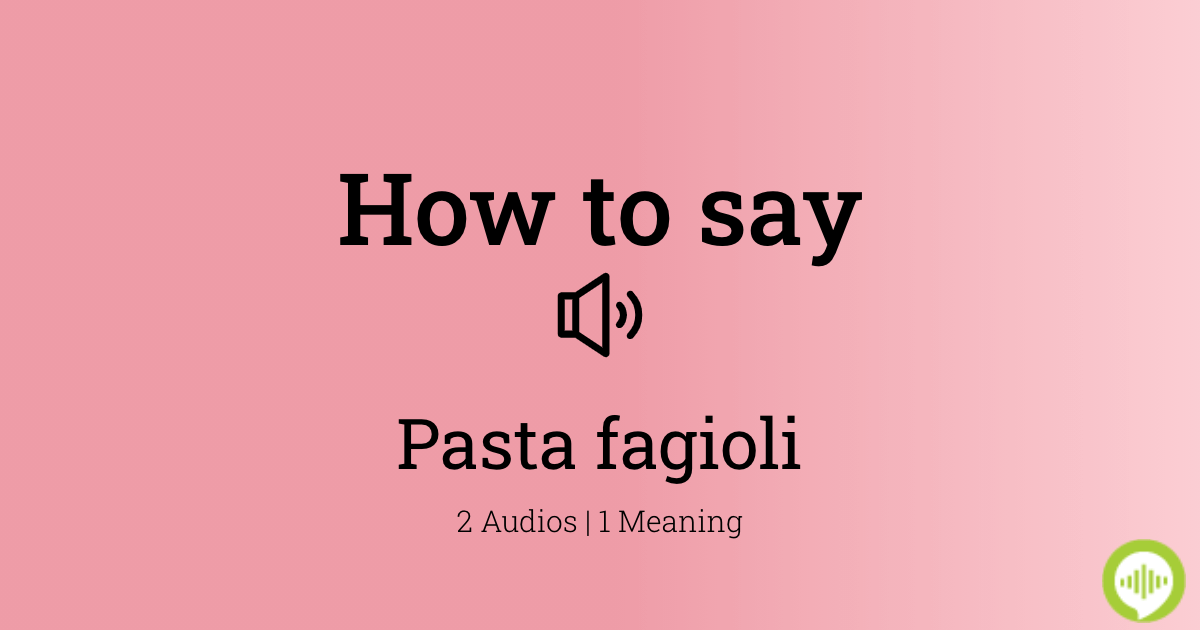Ever found yourself tongue-tied, yearning to savor the authentic flavors of Italy, but stumbling at the very first hurdle: the pronunciation? Mastering the art of pronouncing "pasta e fagioli" unlocks not just a dish, but a cultural experience, a journey into the heart of Italian culinary tradition.
For aficionados of Italian cuisine, the name "pasta e fagioli" likely conjures images of steaming bowls, rich broths, and the comforting embrace of a truly classic dish. Its a staple, a cornerstone of Italian kitchens, enjoyed by people worldwide. This hearty soup, more than just a meal, is a testament to Italian simplicity and a celebration of fresh, quality ingredients. The appeal lies in its simplicity: pasta, beans, tomatoes, vegetables, and a symphony of herbs and spices, coming together to create a dish that is both deeply satisfying and endlessly adaptable.
Navigating the intricacies of Italian pronunciation can seem daunting at first. But fear not! This guide offers an accessible path to mastering "pasta e fagioli," transforming you from a hesitant novice to a confident culinary explorer. Whether you're a dedicated pasta lover or simply a language enthusiast, the journey to correctly pronounce this classic Italian dish promises both a satisfying experience and a delightful discovery. The key is a gentle emphasis on the second syllable and the "j" sound in fagioli. With a little practice, you'll be able to not only order "pasta e fagioli" with assurance, but also share the joy of this wonderful dish with others.
The heart of "pasta e fagioli" lies in its translation. "Pasta e fagioli" translates to "pasta and beans." This seemingly simple combination embodies Italian resourcefulness and the art of transforming humble ingredients into something extraordinary. It's a testament to how simple ingredients, when combined with care and culinary skill, can create something so delicious and widely enjoyed. The soup is a canvas for regional variations, with families and chefs alike adding their own unique touches. But the core remains consistent: pasta, beans, a rich broth, and the warmth of Italian hospitality.
In the New York Italian dialect, due to Neapolitan influences, the dish is often referred to as "pasta fasul" or "pasta fazool." This illustrates the regional nuances within Italian culture and how pronunciation and dish names can change across geography and time. The influence of Neapolitan cuisine is significant, explaining why many people in the United States have a slightly different way to pronounce the dish.
Here's how to break it down:
Pasta: Pronounced PA-sta (rhymes with "pasta" in English)
e: Pronounced "eh" (like the "e" in "bed")
Fagioli: Pronounced fa-JO-lee (with a soft "j" sound, like the "s" in "measure," and emphasis on the "JO" syllable)
With this in mind, you can also learn how to say the ingredients in different languages. For example, In French, you would say "ptes et haricots", in Spanish, "pasta y frijoles" and in German, "Nudeln und Bohnen."
The journey of learning to pronounce "pasta e fagioli" is an accessible path to appreciating the deliciousness of Italian food. And to assist, let's look at a few more classic Italian dishes:
- Risotto: A creamy rice dish.
- Lasagna: A baked pasta dish with layers.
- Pizza: A flatbread with toppings.
- Spaghetti Carbonara: A pasta dish with eggs, cheese, and pancetta.
So, embrace the challenge, and start pronouncing pasta e fagioli like a pro. The delightful taste of Italian cooking and the experience of the Italian language will surely make you a fan of the cuisine. So unlock the secrets of Italian cuisine with our easy guide on how to pronounce "pasta e fagioli".
One of the best things about pasta e fagioli is that it has endless variations for making, as regional differences and family traditions play a role in the dish's overall flavor. The beauty is that it can be tailored to your own preferences, whether it be the type of beans, pasta, or herbs.
You can find recipes in English, French, Spanish, German, Hindi, or whatever language you prefer, however, you'll notice that the way to say it never changes. Whether you are a seasoned chef, a home cook, a language enthusiast, or anyone in between, learning to pronounce this dish is simple. With our easy guide, you will be pronouncing "pasta e fagioli" with confidence in no time.
Remember to put the emphasis on the second syllable, and the 'j' sound from fagioli. After that, all that is left is to share the joy of Italian cooking with your friends and family.
The video available will also teach you how to pronounce pasta fagioli correctly. It breaks down the name in the correct order, so that you can see how each syllable is said.
When ordering this dish in a restaurant, you will be able to say it correctly, while impressing the staff or fellow diners.
As we've seen in the New York Italian dialect, there can be some confusion around how to say it. This is because of the Neapolitan influence. But don't worry, by looking at our easy guide, you will know how to say it correctly.


